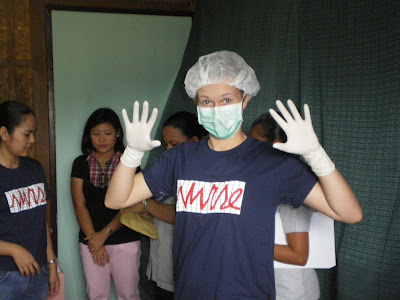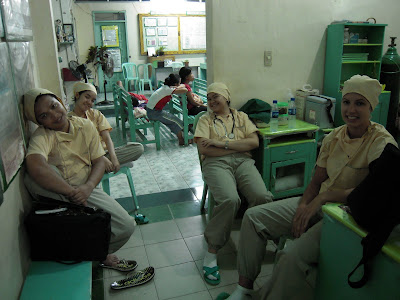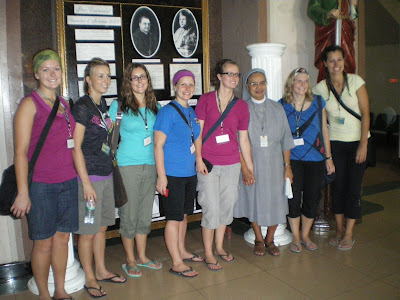January 25
th to 28
th
The morning of January 25
th we left
Iloilo with the St. Paul's nursing students and travelled to the province of
Janiuay. This was a unique week as we were going to be living with the students at the university's staff house. There were 22 people staying at the staff house, including both groups of students, two faculty members from
SPU, Dr.
Mahli Brindamour and Dr. Ryan
Meili, from Saskatoon. While staying at the staff house the students took turns with cooking and cleaning duties. This was a new experience for us as we not only had to learn how to cook Filipino dishes and buy food from the market, but also how to cook over an open coal fire.
While in
Janiuay we spent our mornings in Rural Health Unit (
RHU) which is the main health center for this area.
RHU provides many different
services within a small facility. We were paired up with our buddies at different stations and were able to rotate posts throughout the week. Some of our experiences including working at the
IMCI desk, the assessment area, the prenatal area, treatment room which included immunizations and wound dressings, and consultations with the doctors. This clinic also includes a labour and delivery room where we were on call during our time in
Janiuay.
When clients arrive at the clinic they are first seen at the assessment desk. At this station we take the client's vital signs,
chief complaint, history, and then do a focused assessment. Anyone under the age of five years old is managed through
IMCI, anyone over five years is seen by the doctor. This was exciting for us because in Canada we have not yet had the opportunity to be the first person doing the initial
assessment. Some of the cases consisted of hypertension, cold and fever, breast pain with a possible lump, abdominal pain, diarrhea, nausea and ear pain.
Considering we are Canadian students who do not speak the native languages of the Philippines, we relied heavily on our buddies to assist us with all of our interactions with clients. "Effective communication and teamwork is essential for the delivery of high quality, safe patient care. Communication failures are an extremely common cause of inadvertent patient harm" (Leonard, Graham,
Bonacum, 2004). We also had to rely more on the clients non-verbal communication in an attempt to pick up anything missed in translation.
At the
IMCI station we used the standardized framework to further assess all children under 5 years old. If the child is showing any of the 4 danger signs (convulsions, vomits everything, not able to drink or breastfeed, or abnormally sleepy or difficult to awaken) they will be seen by the doctor. If not they are diagnosed, treated and cared for by the nurses. The different conditions which
IMCI is assessing includes measles, dengue hemorrhagic fever, malnutrition and anemia, ear problems, fever, malaria, and
diarrhea. The most common cases we saw were cough and fever.
We were able to work along side Dr.
Mahli Brindamour and Dr. Ryan
Meili during their consultations with patients. This is something that we rarely have the opportunity to do in Saskatchewan, so we are very
grateful. During this time the doctors also relied on the
SPU students for translation. Some of the cases observed were patients with a cough and cold, hypertension, kidney infections, query pneumonia, infected wounds, and dengue fever. The positive diagnosis of dengue fever was achieved though the
tourniquet test. This was our first opportunity to ever observe this test.
During our prenatal assessments we were able to
further advance our skills. Here we took the mothers blood pressure, measured
fundal heights,
auscultated the fetus's heart rate, did
Leopold's maneuvers, and gave the mother
necessary tetanus injections.
In the treatment area we were able to give many immunizations. Here we were able to give injections children under 5, which we have not had the opportunity to do in Canada. Some of he injections included Hepatitis B,
measles, tetanus, DPT (
diphtheria,
pertussis and typhoid). We also got to administer the oral polio vaccine. There were also many wounds we were able to clean and

dress.
Our afternoons were spent in
Sitio Asinan and
Sitio Gamad, which are 2
Barangays in
Juniuay. Here we chose one family in which we did a complete family assessment. We assessed such things as living conditions, medical history, income, education levels, work life, spirituality, physical and mental status, relationships, community involvement, and what the community feel they need most. These families were extremely welcoming not only to the Filipino students but also to us. We also went into other homes to assess vital signs.
One of the major problems we observed in these communities was the lack of toilet facilities, running water and proper garbage disposal. The majority of the parents within the community had a low level of education and some of the children were not attending school. These families had small incomes which made it difficult to purchase food and proper footwear. The combination of all of these determinants increases the risk of contracting parasites and infections (
Nematian,
Nematian,
Gholamrezanezhad &
Asgari, 2004).

On our last day in the community we held an assembly for both of the
Barangays. At the assembly we had all of the guest register which included checking vital signs, as well as heights and weight of those under 5 years. The Canadian students created a modified version of snakes and ladders which included health teachings the children. The Filipino students were responsible for creating a game for the mothers. We also participated in role playing to help teach the mothers proper parenting regarding feeding. This assembly helps the Filipino students, who will be working in these
Barangays in the next several weeks, evaluate the health status and needs of the communities. Following the games we performed a dance to the popular song, ‘nobody’ and handed out healthy snacks for everyone.

Thursday, January 28
th we spent the morning presenting research to each other on different health concerns prevalent in the Philippines. In the afternoon we attended
Januiay's festival and then travelled back to
Iloilo.
Top picture: Us in our
Iloilo uniforms
Second picture: Kirsten, Chelsea and JP doing wound care
Third picture: Melissa assessing a family
Bottom picture: Us playing our game with the children at the assembly


 We would now like to take this opportunity to thank all of those who helped facilitate our time in the Philippines. These include, but are not limited to, the Dean’s of nursing Dr. J. Tuazon, UPM, Dr. C. Divinagracia, UERMMMC, and Sr. Carolina Agravante, SPC, President, St. Paul Univeristy, Iloilo, all of whom welcomed us into their schools whole heartedly. Also, the many faculty members who helped us receive an extraordinary clinical experience, including Jerry, Ruby, Mrs. Lim, Ms. Castro, Ms. Mollo, and Zandro. You were all amazing and taught us so much, thanks! We would like to extend another huge thank you to all of the nursing students who acted as our “buddies” and our personal translators while working in the community. We have formed new and lasting friendships and are looking forward to maintaining these contacts in the future. Thanks goes out to Lorna Butler from the University of Saskatchewan, who helped make this trip possible, as well as our instructor Susan Fowler-Kerry who believed in us enough to allow us to partake in this experience. Lastly, thank you to all of those who followed our blog and took interest in sharing our experiences. We bid you adieu.
We would now like to take this opportunity to thank all of those who helped facilitate our time in the Philippines. These include, but are not limited to, the Dean’s of nursing Dr. J. Tuazon, UPM, Dr. C. Divinagracia, UERMMMC, and Sr. Carolina Agravante, SPC, President, St. Paul Univeristy, Iloilo, all of whom welcomed us into their schools whole heartedly. Also, the many faculty members who helped us receive an extraordinary clinical experience, including Jerry, Ruby, Mrs. Lim, Ms. Castro, Ms. Mollo, and Zandro. You were all amazing and taught us so much, thanks! We would like to extend another huge thank you to all of the nursing students who acted as our “buddies” and our personal translators while working in the community. We have formed new and lasting friendships and are looking forward to maintaining these contacts in the future. Thanks goes out to Lorna Butler from the University of Saskatchewan, who helped make this trip possible, as well as our instructor Susan Fowler-Kerry who believed in us enough to allow us to partake in this experience. Lastly, thank you to all of those who followed our blog and took interest in sharing our experiences. We bid you adieu.
























